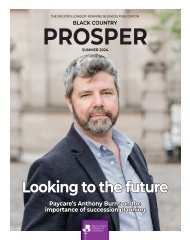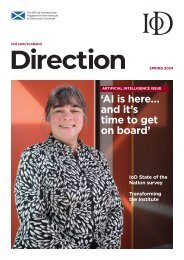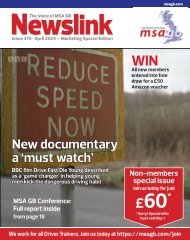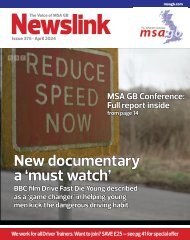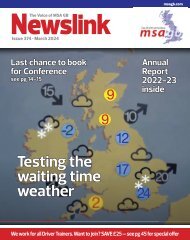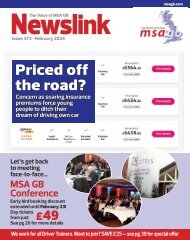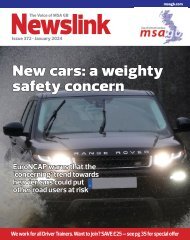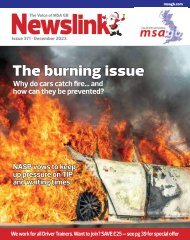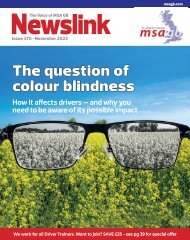MSA Newslink November 2021
Motor Schools Association, driver training and testing, road safety
Motor Schools Association, driver training and testing, road safety
You also want an ePaper? Increase the reach of your titles
YUMPU automatically turns print PDFs into web optimized ePapers that Google loves.
For all the latest news, see www.msagb.com<br />
Right, the BSL alphabet: While this<br />
is standardised, many regional<br />
variations have crept into sign<br />
language that makes it challenging<br />
for deaf pupils to follow exactly the<br />
signing used on the theory test<br />
from the lip. How does a pupil see that<br />
when they are focused on the road? I<br />
tend to use the sign for the Irish letter ‘R’<br />
within their vision and point.<br />
It’s an example that when teaching a<br />
deaf pupil to drive, placement of the<br />
signing is very important; they must be<br />
able to see the instruction.<br />
Understanding deaf culture is also very<br />
important. To get a deaf person’s<br />
attention, when they’re not looking at<br />
you, it can be done by stamping the floor<br />
or touching the person. It’s not practical<br />
to stamp on the floor of the car with all<br />
the normal vibrations going on, so<br />
tapping their arm gently is the best<br />
option. However, this goes completely<br />
against everything an ADI is taught – ‘no<br />
physical contact’ is drummed into us in<br />
training.<br />
This was evident when I explained this<br />
to my enforcement officer on my<br />
standards check. He asked me to get my<br />
pupil’s permission to touch her arm if I<br />
needed to get her attention in front of<br />
him before starting the standards check.<br />
How did he think I coped every week<br />
when he wasn’t around...?<br />
For all the challenges, teaching deaf<br />
pupils to drive is an amazing experience,<br />
but the barriers are always in their way,<br />
both in sitting the theory test and next<br />
getting through the practical test.<br />
For a deaf person to sit and pass a<br />
theory test is an immense challenge. The<br />
barriers placed here are huge. Language<br />
barriers, grammar and understanding of<br />
the English language in written form.<br />
Resources available for deaf candidates<br />
are few and far between, a Highway<br />
Code BSL DVD is available, however, if a<br />
deaf candidate struggles with written<br />
English then finding a BSL Theory App is<br />
impossible. Why? None are available,<br />
therefore many deaf learners will fail at<br />
the first hurdle.<br />
Deaf candidates are allowed to request<br />
‘‘<br />
From my experience I’ve yet<br />
to meet an examiner who can<br />
sign. Luckily, unlike on the<br />
theory test, I can interpret for<br />
my pupils... until, of course,<br />
Covid came along, and ADIs<br />
were no longer allowed to sit in<br />
the back on a test<br />
‘‘<br />
an interpreter when sitting their theory<br />
test however, interpreters (through no<br />
fault of theirs) often do not show up.<br />
This is a common issue throughout a<br />
deaf person’s life, unfortunately.<br />
The DVSA provides onscreen<br />
interpreters. Many issues arise from this.<br />
A question can be signed in English Sign<br />
Language (remember, regional<br />
differences exist within BSL) and the<br />
answer can be signed in Welsh Sign<br />
Language. With an interpreter not<br />
showing or not booked in on time, the<br />
pupil can be stressed and feeling<br />
pressured into just trying the onscreen<br />
interpreter and hoping for the best. This<br />
normally results in a fail which then<br />
dents confidence and adds additional<br />
expense.<br />
If the deaf pupil is successful in<br />
passing their theory test, the next hurdle<br />
is the practical test.<br />
From my experience I’ve yet to meet<br />
an examiner who can sign. Luckily,<br />
unlike on the theory test, I can be there<br />
to interpret. That was, of course, until<br />
the Covid-19 pandemic. Since its arrival<br />
in February 2020 ADIs have not been<br />
allowed in the back of the car. For a deaf<br />
candidate presenting for test this can be<br />
a real barrier. I have had to prepare<br />
sheets with all signs used by myself and<br />
my pupil, giving a visual written<br />
explanation to the examiner including<br />
how directional signs work and where to<br />
place them.<br />
I am allowed to interpret the<br />
declaration the candidate signs and the<br />
‘tell me’ question. After that they are<br />
completely on their own.<br />
As prepared as any pupil can be for<br />
test, it can still be an intimidating<br />
experience – consider how it is for a deaf<br />
pupil when full communication is<br />
unavailable and they’re solely reliant on<br />
a limited set of instructions. Not to<br />
mention how the examiner may feel –<br />
they are, after all, in unfamiliar territory<br />
too, we must remember that.<br />
When the pandemic hit the majority of<br />
ADIs had to down tools for a large part of<br />
a year.<br />
This gave me time to re-evaluate what<br />
I actually did, where I could take my<br />
business and how to move it forward.<br />
Teaching physical disabilities really<br />
interested me and I looked into how this<br />
could be achieved.<br />
Continued on page 22<br />
NEWSLINK n NOVEMBER <strong>2021</strong><br />
21



